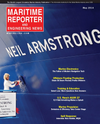
Page 38: of Maritime Reporter Magazine (May 2014)
Marine Electronics Edition
Read this page in Pdf, Flash or Html5 edition of May 2014 Maritime Reporter Magazine
38 Maritime Reporter & Engineering News • MAY 2014
T he U.S. Navy, and the aero- nautic fi eld in general, has benefi ted enormously from the genius of more than one
Sperry. Lawrence Burst Sperry, the sec- ond son and third child of gyrocompass inventor Elmer A. Sperry was a pioneer in instrumental fl ight and famous in- ventor in his own right, launching the
Lawrence Sperry Aircraft Co. at 26, and earning 23 patents before his untimely death at the age of 31 in 1923. Avia- tion promoter and Air Service General
Billy Mitchell lauded him as one of the most brilliant minds and greatest devel- opers in the world of aviation, while one newspaper called him “Uncle Sam’s youngest technical expert and aviator.”
It was no exaggeration.
Like his father before him, Sperry’s engineering brilliance more than made up for his lack of a college degree, and he too achieved acclaim in his early 20s as an innovator and inventor, primarily in aviation.
The youngest licensed pilot in the country, Lawrence fi rst gained fame as the inventor of the autopilot, a small gy- roscopic stabilizer for planes that con- trolled the three axes of fl ight — yaw, pitch and roll —to maintain course and altitude.
Most ships today still use a Sperry- type stabilizer to dampen rolling, along with some version of a Sperry autopilot linked to a Sperry gyrocompass.
He also invented the artifi cial hori- zon; a turn and bank indicator; the fi rst amphibious fl ying boat; an airspeed indicator, a drift indicator, a signifi - cant improvement over the liquid-fi lled magnetic compass and a parachute pack – inventions that formed the basic in- struments of all manner of planes and most of which remain in use today.
A font of ideas, Sperry also tackled night fl ying issues and built the fi rst wheeled retractable landing gear in an amphibian. That got him a splash in the
March 29, 1915 The Aerial Age Weekly.
But it was his performance at French air competition for plane safety in 1914 that turned him into an international star overnight and netted a $10,000 prize.
With his parent looking on, the 22-year- old Sperry and his mechanic wowed the crowd, which included military observ- ers, by walking out on the wings of the plane while it was aloft, to demonstrate his autopilot technology. Sperry, with his hands up in the air, offered a whole new take on “Look Ma, no hands!,” to an incredulous crowd.
By 1916, Lawrence was a commis- sioned junior lieutenant in the U.S.
Navy and assigned as a fl ight instruc- tor. A brief stint on active duty in 1918 was cut short by emergency surgery, enabling him to continue his focus on innovation. He was the fi rst civilian to join the Navy Flying Corps Reserve in 1917.
Working with his father, Elmer A., the two developed one of the earliest drones – an unpiloted aircraft that could fl y to a target guided, once again, by Sperry
Sr.’s gyroscopic device. Despite some initial interest and funding from the
Navy, however, uneven test results and trips back to the drawing board led the
Sperry’s Companies
Inventor-entrepreneur Elmer A. Sperry was fond of launching new companies to manufacture new inventors and support his wide ranging interests, at times folding, morphing or selling off older companies even as he was forming new ones. He is perhaps most closely associated with the Sperry Gyroscope Co.: Sperry Electric Light, Motor, and Car Brake Co., founded at the age of 20 to manufac- ture Sperry’s electric dynamos and arc lamp invention. (1880) Sperry Electric Mining Machine Co. (1888) The Elmer A. Sperry Co., for research and development work (1888) Sperry Streetcar and Electric Railway Co., for electric streetcars and their components (1894) Chicago Fuse Wire Co., (1900); and separately established an electro chemical labora- tory in Washington, DC. , where he discovered a process for recovering tin from scrap metal. Sperry Gyroscope Co. (1910), founded to manufacture navigation equipment, chiefl y his own inventions – the marine gyrostabilizer and the gyrocompass. During World War
I the company diversifi ed into aircraft components, such as bomb sights, fi re control systems, airplane stabilizers and autopilot. Sperry Development Co. (1926), Sperry Products Inc. and Sperry Rail Service - all as- sociated with his rail detector and diesel engine products.
The Sperry companies that remained, including the Lawrence Sperry Aircraft Co., eventually became the Sperry Corp. several years after the deaths of both Elmer Sperry and his son
Lawrence, with the maritime sector spinning off into Sperry Marine in 1997, which eventually became part of Northrup Grumman Corp., a worldwide supplier of navigation, communication, information and automation systems for commercial marine and naval markets.
Also a member of many engineering, aeronautical, maritime, industry and other scientifi cally- oriented organizations, Sperry founded at least two: Founder and charter member of the American Institute of Electrical Engineers Founder and charter member of the American Electro-Chemical Society
He was also an inaugural member and eventual chairman of the U.S. Naval Consulting Board, which was formed in 1915 by the Secretary of the Navy with help from Thomas Edison.
MR’S 75TH ANNIVERSARY (Photo: Hagley Museum and Library)
Lawrence Burst Sperry
Aviator & Engineer
A chip off the old block makes aeronautics his claim to fame
By Patricia Keefe
MR #5 (32-41).indd 38 4/29/2014 12:18:31 PM

 37
37

 39
39
